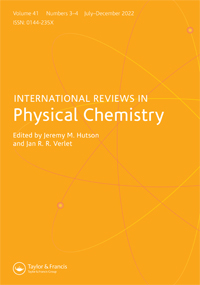Ultrafast two-dimensional infrared spectroscopy for molecular structures and dynamics with expanding wavelength range and increasing sensitivities: from experimental and computational perspectives
IF 2.5
2区 化学
Q3 CHEMISTRY, PHYSICAL
引用次数: 18
Abstract
Abstract Over the last decade, ultrafast two-dimensional infrared (2D IR) spectroscopy has been greatly advanced in a variety of aspects and is becoming a more exciting vibrational tool for understanding the structures and dynamics of condensed-phase equilibrium and non-equilibrium molecular systems, as well as surface-immobilised monolayers or adsorbates. A number of novel multi-pulse experimental schemes have been reported, some of them allow one to simultaneously examine anharmonic vibrational interactions and frequency–frequency correlations among vibrational chromophores having very different vibrational frequencies, particularly in a broadband fashion, providing potentially intrinsic spectroscopic probes for local, regional, and global molecular structures and dynamics; and some of them allow one to access more vibrational levels of a given set of anharmonic oscillators, enabling a better characterisation of their anharmonic potentials and factors influencing them. In this review, we first introduce these basic experimental schemes, mainly focusing on the time-domain methods. We then introduce technological and experimental advances on 2D IR signal detections that can provide much higher spectral resolution and higher sensitivities. Together, these advances can further increase the capacities of these nonlinear infrared methods. Computational considerations and developments on assessing more anharmonic potential parameters and simulating correlated broadband 2D IR spectra are then followed. Examples of the applications of these experimental and theoretical methods are also provided and discussed. We finally conclude this review by summarising these recent developments of the 2D IR methodologies and by discussing more advanced multi-pulse nonlinear IR experiments and their potential applications in near future.扩展波长范围和增加灵敏度的分子结构和动力学的超快二维红外光谱:从实验和计算的角度
在过去的十年中,超快二维红外(2D IR)光谱在各个方面都取得了很大的进步,并且正在成为一个更令人兴奋的振动工具,用于理解凝聚态平衡和非平衡分子系统的结构和动力学,以及表面固定化单层或吸附物。许多新颖的多脉冲实验方案已经被报道,其中一些方案允许人们同时检查具有非常不同振动频率的振动发色团之间的非谐波振动相互作用和频率相关性,特别是在宽带方式下,为局部,区域和全局分子结构和动力学提供潜在的内在光谱探针;它们中的一些允许人们访问给定的一组非调和振子的更多振动水平,从而能够更好地表征它们的非调和势和影响它们的因素。在本文中,我们首先介绍了这些基本的实验方案,重点介绍了时域方法。然后,我们介绍了二维红外信号检测的技术和实验进展,可以提供更高的光谱分辨率和更高的灵敏度。总之,这些进展可以进一步提高这些非线性红外方法的能力。然后介绍了在评估更多非谐波势参数和模拟相关宽带二维红外光谱方面的计算考虑和进展。最后给出了实验和理论方法的应用实例,并进行了讨论。最后,我们总结了二维红外方法的最新发展,并讨论了更先进的多脉冲非线性红外实验及其在不久的将来的潜在应用。
本文章由计算机程序翻译,如有差异,请以英文原文为准。
求助全文
约1分钟内获得全文
求助全文
来源期刊
CiteScore
14.20
自引率
1.60%
发文量
5
审稿时长
1 months
期刊介绍:
International Reviews in Physical Chemistry publishes review articles describing frontier research areas in physical chemistry. Internationally renowned scientists describe their own research in the wider context of the field. The articles are of interest not only to specialists but also to those wishing to read general and authoritative accounts of recent developments in physical chemistry, chemical physics and theoretical chemistry. The journal appeals to research workers, lecturers and research students alike.

 求助内容:
求助内容: 应助结果提醒方式:
应助结果提醒方式:


